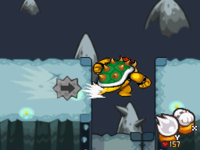Sliding haymaker: Difference between revisions
m (It's lowercase in the text itself (in the Emoglobin's speech bubble). It's only capitalised because it's a heading.) |
(Note the other headers, and how "pipe" is in lowercase two pages back, in the same header style. This means that it was objectively intended to be capitalized, even if the Emoglobin doesn't parse it that way.) |
||
| Line 1: | Line 1: | ||
[[File:Sliding Punch.png|thumb|The Sliding Haymaker]] | [[File:Sliding Punch.png|thumb|The Sliding Haymaker]] | ||
The '''Sliding Haymaker''', also called the ''' | The '''Sliding Haymaker''', also called the '''Sliding Punch'''<ref>''Mario & Luigi: Bowser's Inside Story'' instruction books, page 21 (American) and page 22 (European)</ref>, is one of [[Bowser]]'s moves in ''[[Mario & Luigi: Bowser's Inside Story]]''. Bowser learns this move after [[Mario]] and [[Luigi]] defeat [[Durmite]] in Bowser's [[Nerve Cluster]]. They head further in the area when a lot of [[Biffidus]]es drill down the ice the brothers are currently on, dropping them onto a small area. In this place, they find [[Toadbert]], who is studying a [[nubbin]], which Luigi hits, giving Bowser a tingling feeling in his arm. Toadbert tells them what he believed happened. With this move, Bowser is able to continue his journey. | ||
To perform the move, the player must punch normally using the {{button|ds|X}} button, and hold down the {{button|ds|pad}} in the direction they want Bowser to move. This move can also be used to cross ledges that Bowser would normally be unable to cross on his own (called "Slide Fit" by a sign in [[Bumpsy Plains]] or "Treadmill Fit" by a sign in [[Bowser Path]]) and also break bigger rocks. | To perform the move, the player must punch normally using the {{button|ds|X}} button, and hold down the {{button|ds|pad}} in the direction they want Bowser to move. This move can also be used to cross ledges that Bowser would normally be unable to cross on his own (called "Slide Fit" by a sign in [[Bumpsy Plains]] or "Treadmill Fit" by a sign in [[Bowser Path]]) and also break bigger rocks. | ||
Revision as of 22:08, April 8, 2019
The Sliding Haymaker, also called the Sliding Punch[1], is one of Bowser's moves in Mario & Luigi: Bowser's Inside Story. Bowser learns this move after Mario and Luigi defeat Durmite in Bowser's Nerve Cluster. They head further in the area when a lot of Biffiduses drill down the ice the brothers are currently on, dropping them onto a small area. In this place, they find Toadbert, who is studying a nubbin, which Luigi hits, giving Bowser a tingling feeling in his arm. Toadbert tells them what he believed happened. With this move, Bowser is able to continue his journey.
To perform the move, the player must punch normally using the ![]() button, and hold down the
button, and hold down the in the direction they want Bowser to move. This move can also be used to cross ledges that Bowser would normally be unable to cross on his own (called "Slide Fit" by a sign in Bumpsy Plains or "Treadmill Fit" by a sign in Bowser Path) and also break bigger rocks.
Names in other languages
| Language | Name | Meaning | Notes |
|---|---|---|---|
| Japanese | 歩きながらパンチ Arukinagara panchi[?] |
Punch While Walking |
References
- ^ Mario & Luigi: Bowser's Inside Story instruction books, page 21 (American) and page 22 (European)
